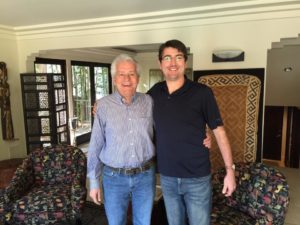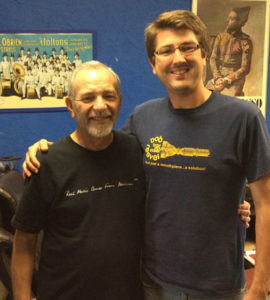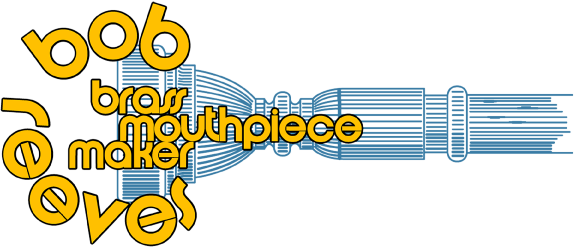
Jerry Hey with John Snell

Larry Hall with John Snell
The Trumpet Routine
Mr. Adam ascribed to the “rest as long as you play” concept. Practicing with a friend helped insure that and also gets one used to playing in front of others. Our daily practice was broken up into sessions. None of this was rigidly adhered to. The 1st session was pretty much the same everyday, but sessions 2 and 3 were pick and choose to keep things fresh, interesting and challenge ourselves. Our practice session times could total 4 to 5 hours. Mr. Adam always said 3 hours was a minimum comprised of an hour for: basic maintenance, technique, and solo and repertoire literature.1st Session
Clarke #1- Start on F# in the staff, F, G and expand outward. The rest of the 1st session of the day is all Schlossberg:- #6 – Start soft, Crescendo to next bar and Decrescendo
- #23, 24,25, 27
- #36B – Start with variation A, then variations 2, 3, 4 and 5 going up a half step with each variation.
- # 95 – Sustain top notes resting or trading off with you partner at each breath mark.
- #97* – The goal was to play in one breath. Keep air relaxed. This can be extended out to F#.
- #99 & #100 – Play #99 as is resting at the end of each key signature, Start #100 on low F# and extend exercise to F# an octave up or keep going as high as you can.
- #102a* – Each day pick a different variation of scales, (major, minor, harmonic minor). Also pick a variation of intervals, (3rds, 4ths, 5ths). Extend outward to F#.
- #120-123, #128
2nd Session
Next session start with Clarke 2nd , 3rd or 4th Study. Always start on E below the staff and expand outward to low F# and C in the staff. When playing the 2nd Study, change modes on each repetition, Major, Minor, Diminished scales. Arban’s P. 14 #16-27 – Play each exercise twice, 1st time all slurred, REST, 2nd time all single tongued. Play a few articulated 8VA. Arban’s #46-50 – Start with #47 and #48, transpose each in all keys. Then play #49, #50, then #46. Schlossberg #45 Arban’s double tonguing P. 175, #77-94 – Play #88-90 in all keys Some Arban’s triple tonguing Schlossberg Chord Studies #70 single tongue, #71 slur 1st 2 notes tongue next 2, #73 All Slurred Arban’s p.297 Characteristic Study #13 The goal is to play in one breath. “Never heard anyone make it!” – J Other Arban’s :- p.39 #3,4,5. p.40, p. 41
- p.138 #35, 38, p.140 #41-47
- p.142-p.151, p.56
- p.125 #1, p.135 #23
- p.28-36 Single tongue 8th notes, double tongue 16ths.

